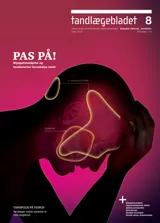Mikrodonti og hypodonti efter kemoterapi af børn
Introduktion – Overlevelsesraterne efter cancer i børneårene er forbedret betydeligt i de seneste 25 år. Senfølger efter behandlingen har derfor tiltrukket sig øget opmærksomhed. Formålet med dette projekt har været at undersøge, om der kan påvises en association mellem kemoterapi før otteårsalderen og forekomsten af 1) mikrodonti og 2) hypodonti. Materiale og metoder – Undersøgelsen er baseret på data i Dansk Børnecancer Register (DBCR). I alt identificeredes 150 børn, som opfyldte inklusionskriterierne. Kontrolgruppen bestod af en randomiseret udtrukket stikprøve af børn i en stor kommunal tandpleje. Resultater – Der blev fundet mikrodonti af i alt 88 præmolarer og første permanente molarer fordelt på 29 (19,3 %) af de 150 inkluderede børn, medens ingen i kontrolgruppen havde mikrodonti af præmolarer eller molarer (differens: 19,3 %; 95 % CI: 13,5 %; 26,4 %). Jo yngre barnet var, da det blev behandlet, jo hyppigere blev der fundet mikrodonti. I alt blev der fundet hypodonti af 27 præmolarer og permanente molarer fordelt på 14 (9,3 %) af de 150 inkluderede børn og 18 præmolarer og permanente molarer hos 8 (4,1 %) af børnene i kontrolgruppen (differens: 5,2 %; 95 % CI: –0,1 %; 11,3 %). Konklusion – Denne undersøgelse bestyrker tidligere undersøgelsers fund af en høj forekomst af mikrodonti og hypodonti hos børn, der har modtaget kemoterapi. Denne sammenhæng er særlig tydelig hos børn, der er behandlet tidligt.
Microdontia and hypodontia after chemotherapy in children
Introduction – Adverse long-term general and dental health effects of cancer and cancer therapy during childhood have been reported. Aim – To examine the association between chemotherapy before the age of 8 years and (1): microdontia; (2): hypodontia of premolars and permanent molars. Material and methods – The study is based on data stored in The Danish Registry of Childhood Cancer (DBCR). A total of 150 children fulfilled both the inclusion criteria and the exclusion criteria. As a control group, a random sample of 193 age-matched unexposed children was included. Results – Microdontia was found in a total of 88 teeth in 29 (19.3 %) of the 150 children who had been exposed to chemotherapy, while none of the controls had microdontia (difference: 19.3 %; 95% CI: 13.5 %; 26.4 %). The earlier the exposure, the more frequent was microdontia. We found a total of 27 missing premolars and permanent molars in 14 (9.3 %) of the exposed children and a total of 18 missing premolars and permanent molars in 8 (4.1 %) of the controls (difference: 5.2 %; 95 % CI: –0.1%; 11.3 %). Conclusion – The present study confirms findings from previous studies that chemotherapy, especially in very young children, causes microdontia and hypodontia of premolars and permanent molars.


